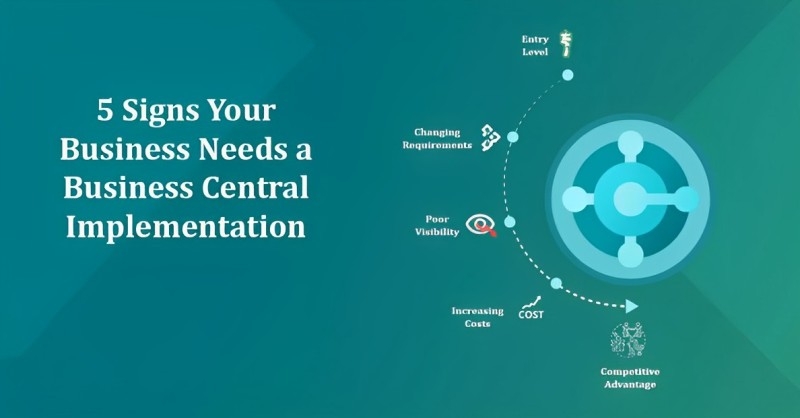Are you curious to know how businesses have transformed themselves for the better?
Let us explore some incredible real-life success stories where companies achieved remarkable changes using Business Central services.
While the advantages of digital transformation are obvious, not every organization finds it easy to realize its full potential.
Let’s delve into the benefits of digital transformation services and inspiring examples showcasing the power of transformation and innovation.

The Benefits of Digital Transformation Using Business Central
To achieve the business benefits of digital transformation, companies must focus on outcomes and specific business imperatives.
Sanjay Srivastava, a top digital expert at Genpact, talks about how companies benefit from going digital in three big ways: making customers happier, doing work faster, and making supply chains work better.
When companies use new tech, data, and AI together, it helps them work better, make customers happier, and earn more money.
Notable Examples of Digital Transformation Success Stories
Actual instances where businesses made significant changes using technology give us helpful ideas on how other companies can do the same.
Now, let’s examine seven impressive success stories and see what lessons they can teach us.
1) Domino’s Pizza: Reinventing the Pizza Experience
After its stock price fell in 2008, Domino’s Pizza embarked on a digital transformation. They improved their menu and became more flexible by utilizing technology.
One of their big successes was introducing Domino’s Tracker, a new delivery technology. This allowed customers to follow their orders online.
By embracing digital changes and making it easy for customers to use their service on various devices, Domino’s changed from a pizza company to an online store.
2) Capital One: From Bank to Technology Firm
Capital One aspired to transition from a traditional bank to a technology-driven enterprise.
Capital One offers tailored banking services quickly by embracing current technology, utilizing big data and machine learning, and utilizing agile software development approaches.
They prioritized cloud computing, moving all of their apps and systems to Amazon Web Services.
This move helped them concentrate on creating innovations centered on customers and converting data into valuable insights.
3) Walmart: Making Shopping Faster and Easier
Walmart’s digital transformation journey focused on making shopping faster and easier for customers while offering new digital experiences.
The company invested heavily in digitalizing its supply chain, sales, customer service, marketing, and store operations.
Strategic partnerships with Microsoft and Google enabled Walmart to leverage cloud computing and voice-enabled shopping, further enhancing their operational efficiency and customer experience.
Walmart’s success lies in getting the basics right and delivering a seamless, customer-centric experience.
4) Tesla: Leading the Electric Vehicle Industry
Tesla, famous for leading the way in electric cars, took a different path in the car industry. They stood out by being innovative and using lots of technology in their cars. Let’s explore how Tesla changed the electric car market and was different from other carmakers.
Tesla’s Unique Approach: Tesla shook up how cars were usually made. They concentrated on making electric cars and packed them with high-tech features.
They introduced updates for their cars using the internet, which let them fix issues, make improvements, and add new things without needing customers to go to repair shops.
Direct Sales to Customers: Tesla didn’t sell its cars like other car companies. Instead of using dealerships, they sold cars directly to people.
They talked directly to buyers through their stores and websites, without the usual middlemen. People could personalize and buy cars without dealing with salespeople.
Making Everything In-House: Tesla changed how cars were built by making important parts, like batteries and motors, by themselves.
By doing everything in their factories, they had more control over quality, costs, and making new things.
Always Making New Things: Tesla keeps doing new things with their cars all the time.
They’re always adding new features and technologies to their vehicles, making other companies follow their lead.
By always being ahead in making new stuff, Tesla keeps being the best and stays ahead of others.
Better Than Regular Car Companies: Tesla’s way of selling cars and using advanced technology gave them many advantages over other car companies.
Their direct sales and use of lots of technology in cars gave customers a special experience.
Their ability to change things quickly and introduce advanced features, like the Gigafactories, kept them leading the industry.
How Tesla Succeeds: Tesla’s success comes from always trying new things, using technology, and rethinking what a car can be.
They made cars that are like gadgets, setting new standards for electric cars and changing how we see driving.
By staying focused on using renewable energy and always improving their cars, Tesla became a big name in electric cars.
5) Leveraging Augmented Reality in the Automotive Industry
Car makers are using fancy AR tech to make their vehicles cooler. They’re collaborating with tech firms to make this fantastic idea a reality.
Augmented reality is a unique technology that assists people working on cars in communicating more effectively with each other.
For example, when a car needs fixing at a dealership, the people there can use AR to talk to other experts who know more about fixing cars. This helps them solve problems with cars more quickly and correctly.
Augmented Reality (AR) is super cool because it’s like using special glasses or goggles that display extra info about what you’re seeing.
These glasses let the people working on cars share information with other experts far away, making it easier to solve complicated car issues.
This way, problems with cars get fixed faster, and people are happier because their cars get fixed right the first time.
Car companies are using AR to make sure that everyone who works on cars knows exactly what to do to fix them.
It’s like having a super-smart helper with special glasses who shows you how to solve problems.
This makes the experience of getting your car fixed better for you and for the people who help fix cars.
The success of using augmented reality in the automotive industry shows how new technology can help solve problems quickly and make customers and employees happier.
This way of using technology in car repair shops is making things easier, faster, and better for everyone involved in fixing cars.
6) Financial Institutions Embrace FinTech
Financial institutions, like banks, have been changing how they work to be more like financial technology companies, also known as fin-tech companies.
These changes have been inspired by the success of smaller, more innovative financial businesses.
To make this change, banks have been making their technology and how they do business match up better.
They’ve restructured their teams and improved collaboration to concentrate more on their objectives. This has led to enhanced profitability, improved partnerships, and increased employee satisfaction.
Banks are adopting a holistic strategy, making widespread changes across their operations simultaneously.
This way of changing things called a holistic approach, has helped them stay competitive in a financial world that keeps changing fast.
Overall, by changing how they use technology and work together, banks have been getting better at doing business and keeping up with the fast-moving financial world.
7) Accelerating Drug Development in the Healthcare Industry
The healthcare industry witnessed a compressed drug development cycle during the COVID-19 pandemic, thanks to digital transformation Consultants.
By leveraging data infrastructure, knowledge graphs, and collaborative platforms, pharmaceutical companies accelerated the speed to market for the COVID-19 vaccine.
This success has prompted many firms to pivot from batch manufacturing to precision medicine, personalized to a patient’s DNA.
The most successful transformation projects in healthcare focus on integrating digital solutions into enterprise workflows, redesigning experiences, driving adoption, and changing operating models to fully leverage the potential of digital technologies.
These real-world examples of digital transformation success stories demonstrate the power of embracing technology and innovation to drive business growth and customer satisfaction.
Whether it’s improving customer experiences, increasing operational productivity, or transforming business models, digital transformation offers significant benefits for organizations across industries.
By learning from these success stories and applying the right strategies and technologies, businesses can embark on their transformative journeys and unlock their full potential in the digital age.



